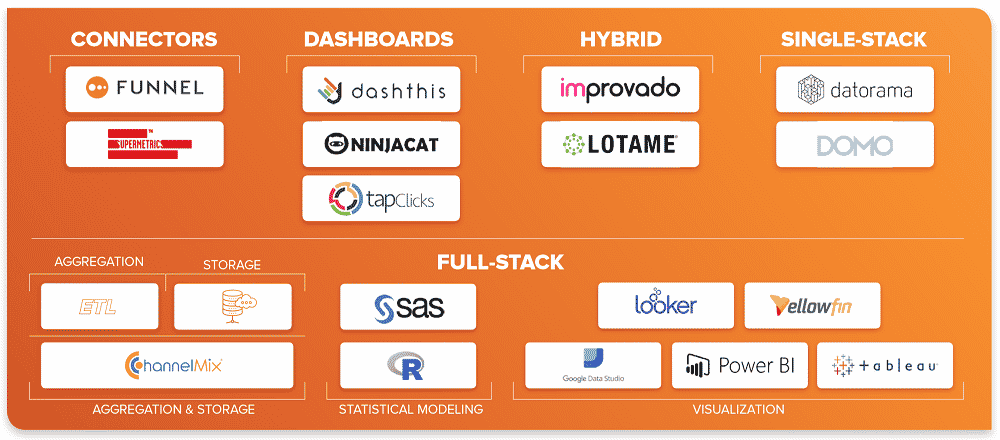Sick of shopping for a marketing analytics platform? You’re not alone. There are so many tools on the market, it can be hard to find the solution that’s perfect for your business.
Here’s the good news: There are really only five types of marketing analytics platforms and software. Once you know which type you need, you’ll find the buying process is much simpler.
We’re going to cover each type and its pros and cons. There’s no single “best choice” — rather, each could be a top performer under the right circumstances. It all depends on what your brand or agency requires.

Connector Tools
A connector tool automates the collection of data from popular sources such as Facebook and Google Analytics. The connector then pushes that data into a spreadsheet like Excel or Google Sheets. You can usually create some basic charts and graphs with the spreadsheet application’s built-in tools.
Connector tools are an example of what we call a Level 1 solution. They’re useful for building “just the facts” performance reports on the most recent month’s clicks, pageviews and other marketing metrics. They’re faster and more accurate than downloading marketing data and pasting it into a spreadsheet. For a lot of analytics teams, reporting automation is a big early win. Supermetrics is a good example of a connector tool.
The major drawback? Connectors typically don’t offer any storage. All the data continues to reside in the originating platform. That means you won’t be able to apply business rules or clean up errors in the data before they appear in your dashboard.
Or what if your analytics program really takes off? You might want to start producing more advanced insights and recommendations — for example, cross-channel marketing attribution, media mix models and forecasting. Those kinds of projects usually take larger amounts of historical data that stretch back years.
So, if you desire to tackle more advanced work, you’ll need to scrap your connector tool and start over with an entirely new platform.
Basic Dashboard Tools
Need to build a marketing dashboard, but don’t have a lot of time or training? Many marketing teams solve this problem with basic dashboarding tools like DashThis.
These are Level 1 solutions that pull performance data from a source and plug it directly into visualizations created by these solutions. They allow you to publish a dashboard fairly quickly.
Usually, the process is as simple as dragging and dropping a widget into the desired spot on your dashboard, adding a logo and calling it a day. Or some software comes with pre-built, professional-looking dashboard templates that you can put to work.
Basic dashboard tools can help teams that need to produce the same basic report multiple times for different audiences — like the monthly update an advertising agency sends to each client.
There are two things to remember about basic dashboard tools.
- They’re fast because almost everything is based on a template. You might be able to make a few tweaks. But you’re going to run into real limits on your ability to customize the dashboard. You might not be able to make it look or function how you need it to.
- Dashboard tools connect to data, but they don’t store data. And they don’t really give you a way to clean up errors or blend data sources together. For agencies or companies that are doing basic, straightforward reports, that might not be an issue.
At some point, though, you might need to build something more complex, and your basic dashboard tool won’t be any help.
Hybrid Tools
This category blends the strengths of connectors and basic dashboard tools. You can push marketing data to a spreadsheet app and visualize it with the hybrid tool itself.
But hybrids also have some of the same weaknesses as Level 1 tools. For one, they usually don’t come with their own storage solution, and you can’t easily blend or cleanse data. And that’s going to limit your ability to produce channel- or campaign-level reporting and other more sophisticated forms of reporting and analysis.
Want to do something cooler later? Get ready to start over with another platform.
Single-Stack Marketing Analytics Solutions
With a single-stack solution, you can aggregate, organize, store and analyze your marketing data with just one platform. Domo and Datorama are both single-stack solutions.
There are real benefits to a single-stack approach. For starters, everything is centralized in one tool, so you can get up and running faster. Single-stack tools also tend to have more out-of-the-box data connections and sharper-looking visualizations than basic dashboard and hybrid tools. Here, it’s possible to do channel- and campaign-level reporting — what we call Level 2 marketing analytics.
Single-stack solutions still require human intervention, though. In some cases, quite a bit.
Take your marketing data, for example. You might buy software that has 1,000 different connectors — except for the one data source you absolutely, positively gotta have. You’ll need someone who can transfer data from that source into your analytics platform, either via a file upload or some other method.
That person will also need to make sure the data is structured correctly so it’ll play nice with everything else you’ve stored in your platform, especially if you’re trying to blend datasets. If there’s a problem with a data connection, your team may be responsible for fixing the issue.
And while single-stack solutions usually include storage, make sure that you’ll be able to feed that data into other platforms or storage solutions. Some single-stack marketing analytics software makes it almost impossible to get your data out of its platform.
Full-Stack Marketing Analytics Solutions
This last category is the most complex, but it’s also the most powerful, with the ability to produce the most valuable forms of marketing analytics.
With a full-stack approach, you use a different best-in-class (or best-for-you) solution to handle a different part of the marketing analytics process.
FULL-STACK REQUIREMENTS
- A platform for automatically aggregating, cleaning and blending your marketing data. Our ChannelMix is the first and best marketing data aggregation platform.
- A storage solution — ideally, an actively managed data warehouse that can hold large volumes of well-structured data stretching back years. And not just marketing data. You’ll also need the power to integrate sales, weather, location, economic and other data into your analysis. You can set up your own data warehouse, or choose a solution that includes warehousing, a feature that ChannelMix offers.
- A dedicated tool for visualization or business intelligence (BI) so you can produce marketing dashboards and other reports. But not a basic dashboard tool. Rather, you’ll want a solution with more sophisticated capabilities and capacity for customization, such as Tableau or Looker.
- And finally, a statistical modeling language and environment, such as R or SAS, for developing predictive analytics, media mix modeling, forecasting and other advanced insights.
A full-stack is the only way to generate Level 3- and Level 4-style marketing analytics. Are there drawbacks? A few. It costs more and takes more time to set up a full-stack solution. You’ll need people, either internal or external, who can take responsibility for modeling and other parts of the process.
FULL-STACK BENEFITS
But there are so many benefits to a full-stack marketing analytics solution.
The most important is the quality of analysis you’ll be able to produce.
Imagine building a media-buying plan that tells you exactly when and where to spend, ZIP code by ZIP code, and even indicates how much new business you can expect from that investment. Or a report that indicates which sales leads look most like your best existing clients, so you can focus your attention on those prospective customers. And that’s just the start.
It’s true that full-stack demands more time and money upfront. But it’s also less likely to break under the demands of really granular, complex analysis. You’re not going to run into as many situations where the software just can’t do something.
Plus, with a full-stack platform, you’re never shackled to one tool. Maybe you decide you hate your BI tool and desperately want to use something else. You have to replace only one piece of your operation, not the whole stack.

Two Things to Remember When Shopping for Marketing Analytics Platforms
As you search for the right marketing analytics platform for your team, here are two guidelines to keep in mind.
Select a solution that fits your team’s unique goals and challenges. If you oversee marketing for a small company, and you just need to monitor your performance on Google Ads, you might meet all your needs with a connector tool or basic dashboarding software.
But always keep an eye on the future. If you do see yourself tackling more complex analytics work in the not-too-distant future — one to three years, as a rule of thumb — look for ways to build a foundation for that day. It might be wise to set up your data in a managed data warehouse now so that it supports predictive analytics later.
Learn More About Marketing Analytics Software
Looking for more expert advice on buying marketing analytics platforms? Get your copy of the No B.S. Buyers Guide for Marketing Analytics, a free report from Alight Analytics. The guide will:
- Give you an easy-to-implement strategy for finding the right solution for your unique marketing analytics needs.
- Highlight the different types of roles you need on your marketing analytics team.
- Show you the most important questions to ask when considering a new platform, so you can get the greatest value for your money.